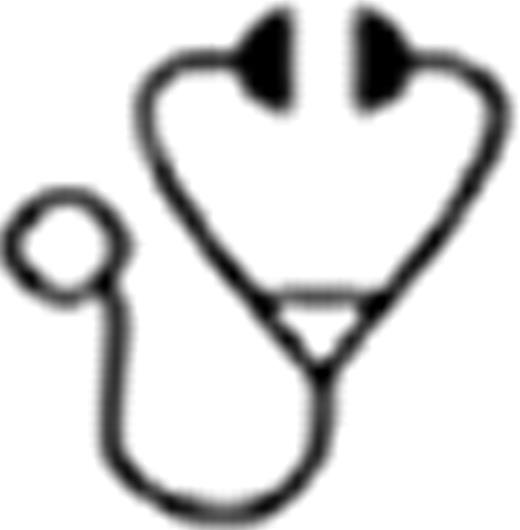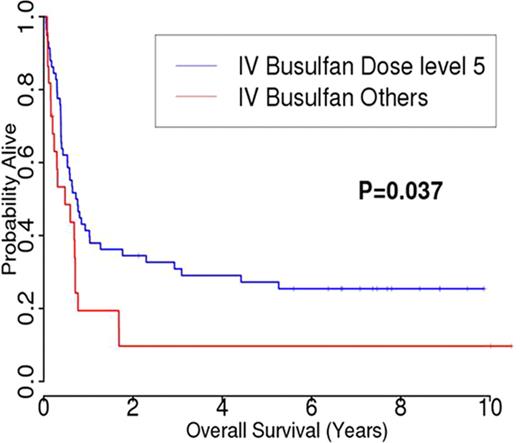Abstract
Busulfan is a well-established conditioning agent in allogenic transplants (alloSCT) with Intravenous Busulfan (IVBu) having better toxicity profile than the oral formulation due to predictable pharmacokinetics. The optimum dose and schedule for reduced intensity regimens of IVBu is not known. We conducted a phase I/II study to determine the best dosing schedule, engraftment kinetics, and efficacy of IVBu with Fludarabine (+/− anti thymocyte globulin, ATG) as a preparatory regimen for alloSCT. Methods: Patients ≤75 years with a HLA-compatible donor (≥5/6 related or 6/6 unrelated) with adequate organ function and Zubrod PS≤2 were included. Fludarabine was given at 30mg/m2 X4 days to all patients and ATG (10mg/kg × 4days) was added for patients receiving mismatched related (MMR) or matched unrelated (MUD) transplants. Tacrolimus and Methotrexate were used for acute graft vs. host disease (aGVHD) prophylaxis. The total dose of IVBu was delivered either as QID (m1) or once a day (m2) schedules (Table 1). The continual reassessment method was used to determine an MTD with a target probability of 20% of grade 3 or 4 conventional toxicity. Phase II was conducted with the MTD selected in phase I for each prognostic stratum, with aim to keep the failure rate below the historical rate and reduce the death rate by 0.20.
Busulfan dosing in the phase I portion of the study
| Dose levela . | Scheduleb . | Total dose . | Number of patients enrolled . |
|---|---|---|---|
| 0 | 0.8 mg/kg × 4doses | 3.2 mg/kg | 2 |
| 1 | 0.8 mg/kg × 6 doses | 4.8 mg/kg | 0 |
| 2 | 0.8 mg/kg × 8 doses | 6.4 mg/kg | 4 |
| 3 | 0.8 mg/kg × 10 doses | 8.0 mg/kg | 4 |
| 4 | 0.8 mg/kg × 12 doses | 9.6 mg/kg | 7 |
| 5 | 0.8 mg/kg × 14 doses | 11.2 mg/kg | 58 |
| 6 | 0.8mg/kg × 16 doses | 12.8 mg/kg | 5 |
| Dose levela . | Scheduleb . | Total dose . | Number of patients enrolled . |
|---|---|---|---|
| 0 | 0.8 mg/kg × 4doses | 3.2 mg/kg | 2 |
| 1 | 0.8 mg/kg × 6 doses | 4.8 mg/kg | 0 |
| 2 | 0.8 mg/kg × 8 doses | 6.4 mg/kg | 4 |
| 3 | 0.8 mg/kg × 10 doses | 8.0 mg/kg | 4 |
| 4 | 0.8 mg/kg × 12 doses | 9.6 mg/kg | 7 |
| 5 | 0.8 mg/kg × 14 doses | 11.2 mg/kg | 58 |
| 6 | 0.8mg/kg × 16 doses | 12.8 mg/kg | 5 |
Older and patients with comorbidities were started at dose level 2 while young and fit patients started at dose level 4.
Once daily dosing was used in 67 (84%) and QID dosing in 13 (16%).
Eighty patients were enrolled (Table 2). Engraftment occurred in 73 patients (91%; 3 early deaths and 4 non engraftments). Day 100 transplant-related (non-relapse) mortality was 8/80 (10%), (infections=3, aGVHD=2, graft failures=2, alveolar haemorrhage=1). Sixty three patients (79%) achieved complete response (CR) after the transplant and at a median follow up of 8.4 months (range, 0.6–125 mos), 62 pts died (38 due to progressive disease). In a fitted multivariate Bayesian lognormal regression model, age (posterior probability of a beneficial effect, PPBE =0.037), poor cytogenetic risk category (PPBE=0.025) and dose level 5 (PPBE=0.983) were significantly associated with OS. Receiving dose 5 was significantly associated with longer RFS (PPBE=0.979 of beneficial effect).
Baseline characteristics of the patients (n=80)
| Parameter . | Value (%) . |
|---|---|
| Age (median) | 56 (10–71) |
| Male sex | 54 (67.5) |
| Diagnosis | |
| AML/MDS | 60 (75) |
| CML | 16 (20) |
| Othersa | 4 (5) |
| Abnormal cytogeneticsb | 50 (62.5) |
| Disease status at transplantc | |
| Complete remission | 20 (25) |
| Refractory/Progressive | 60 (75) |
| BM Blasts >5% | 43 (54) |
| Type of transplant | |
| Matched unrelated | 34 (42.5) |
| Relatedc | 47 (57.5) |
| Stem cell source | |
| Bone marrow | 38 (47.5) |
| Peripheral Blood | 42 (52.5) |
| Parameter . | Value (%) . |
|---|---|
| Age (median) | 56 (10–71) |
| Male sex | 54 (67.5) |
| Diagnosis | |
| AML/MDS | 60 (75) |
| CML | 16 (20) |
| Othersa | 4 (5) |
| Abnormal cytogeneticsb | 50 (62.5) |
| Disease status at transplantc | |
| Complete remission | 20 (25) |
| Refractory/Progressive | 60 (75) |
| BM Blasts >5% | 43 (54) |
| Type of transplant | |
| Matched unrelated | 34 (42.5) |
| Relatedc | 47 (57.5) |
| Stem cell source | |
| Bone marrow | 38 (47.5) |
| Peripheral Blood | 42 (52.5) |
lymphoma=3, ALL=1.
Among those with abnormal cytogenetics, 25 (50%) had poor risk features).
7/47 had 1 antigen mismatch.
Poor risk cytogenetics, active disease at time of transplant and blasts >5% in the bone marrow were predictive of poor survival. IVBu dose level 5 was significantly associated with a better overall survival (OS) and relapse free survival (RFS) (5-year OS 27% vs 9.7%; p=0.014 and RFS 46% vs. 24%; p=0.036; Figures 1&2). On multivariate analysis, dose level 5 was still significantly associated with OS and RFS. Grade ≥2 acute GVHD occurred in 26/73 (36%) patients (grades 3–4 in 8).
Optimizing IVBu dose intensity in the conditioning regimen leads to meaningful survival in poor prognosis AML/MDS, and the higher dose level produced significantly better RFS and OS.
Tables and figures
No relevant conflicts of interest to declare.

This icon denotes a clinically relevant abstract
Author notes
Asterisk with author names denotes non-ASH members.



